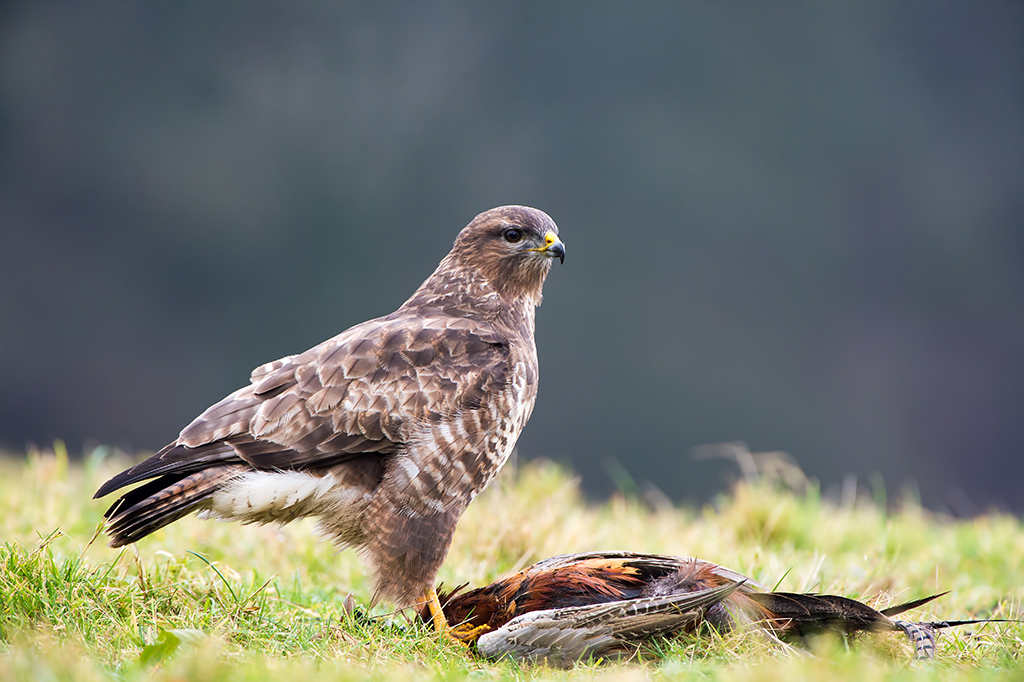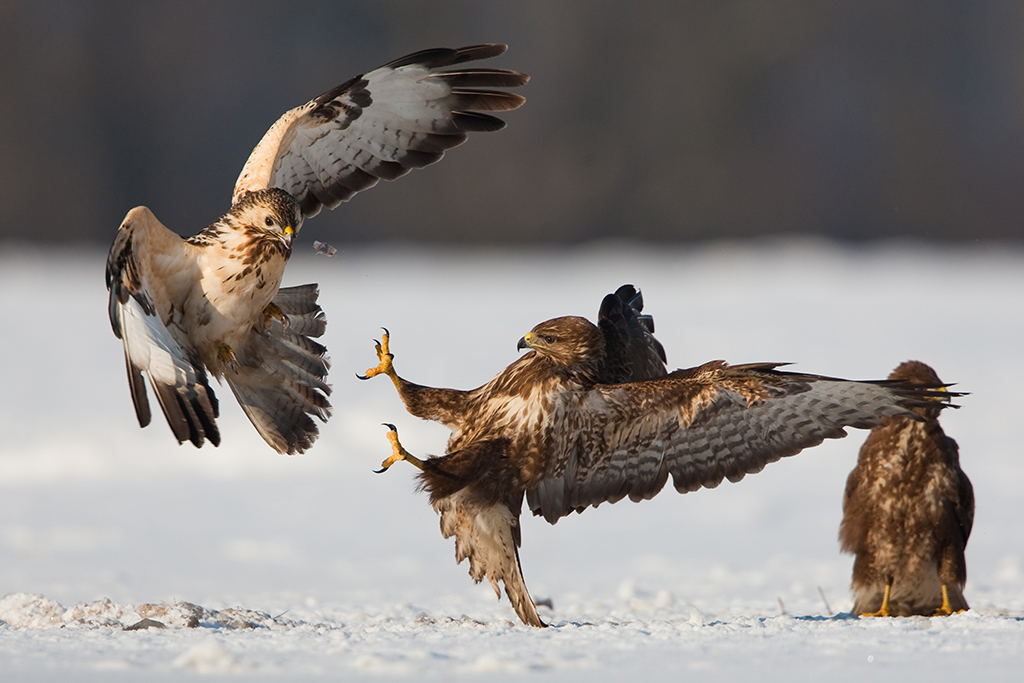
The buzzard is a success story – but it is too successful?
Buzzards are a conservation success story.
The raptors’ numbers are so buoyant that concerns over their impact on other wildlife have been raised and measures as drastic as a cull are being suggested.
It seemed ironic that, shortly after I had despatched a badly injured buzzard filled with shot pellets, that the next visitor to the house began a rant: ‘Buzzards are killing all our wildlife.’ It’s a statement that has been sparking vitriolic debate over the possibilities of a cull.
Having suffered years of persecution, the buzzard is at last back to the kind of numbers seen during the early part of the 19th century, and has re-colonised its old haunts whilst spreading into areas where it has not previously been numerous. Certain conservationists view this as cause for celebration, but the shooting fraternity are far from happy about it.
Though the buzzard was previously extremely common, in around 1830 a serious decline began. Over the next half century it was largely driven from much of its former range, particularly where it conflicted with game interests. Buzzard numbers also declined during the 1950s when the rabbit population crashed due to myxomatosis.
It is widely accepted that the rise in buzzard numbers is largely due to law enforcement, and therefore less persecution. Many conservationists state that the higher numbers merely illustrate just how much illegal persecution was going on. Indeed, despite being a protected species, some argue illegal persecution is still happening. In October of 2014, six buzzards were found dead in a field near Auchenblae, Kincardineshire, though as yet the cause of this is unknown. What is clear is that the word ‘buzzard’ ruffles feathers in both camps.
This catholic feeder is a robust, adaptable bird that takes advantage of any easy prey. It is able to convert relatively small amounts of food into energy and can exist on prey items ranging from earthworms and lagomorphs to small mammals and birds.
The buzzard constantly falls foul of gamekeepers at pheasant rearing pens, especially in July and August when young poults are at their most vulnerable. As one countryman, who prefers to remain nameless, said to me, ‘who can blame a buzzard for taking advantage of a packed pheasant pen? They are lazy birds. Frankly, I think that the British countryside is totally saturated with the pheasant, that is not even a native. I am on the side of the buzzard.’
Approximately 35 million pheasants are released into the wild annually with just 1-2% taken by birds of prey. Even if we were to treble this figure, it’s still not a huge amount, given that at least 30% of pheasants are thought to be killed on roads.
To add to this bubbling cauldron of passion the buzzard is now being blamed for killing red squirrels. Cumbrian sporting estate owner Joe Harris, now in his eighties, regularly shoots in Scotland and told me: ‘In my youth, it was a joy to see a buzzard, indeed I looked forward to it, they are lovely birds. Frankly now, there are just far too many, they are a damn nuisance. You should go and look under a buzzard nest and see how many red squirrel tails there are. Most of us feel strongly that something needs to be done about it, and of course they kill a lot of songbirds too.’

Buzzards will feed on anything from gamebirds to earthworms
There is also a clamour that the pine marten is a threat to red squirrels and capercaillie, yet there appears to be no clear scientific evidence. Many country people have witnessed the behaviour of the now thriving great-spotted woodpecker removing songbird chicks from nests and boxes; even the red squirrel occasionally feeds on young birds. As always with nature, the question of whether an animal causes harm is complex.
Rob Coope, an ecologist and specialist in conservation and wildlife management, said: ‘The key reason for a cull of any species needs to be clear and based on a sound understanding of the underlying ecology. Though some are trying to suggest there is a biological reason for a buzzard cull, there isn’t one that is strictly evidence based. Any experimental culling must be from an independent scientific point of view. Currently the debate has all been managed by game organisations.’
Buzzards are also blamed for the decrease in lapwings and other waders. There is a decline in lapwings in the Hebrides, yet no increase in buzzard numbers. The reasons for the wader decline are far more complex and include a loss of habitat, in particular wintering ground, increasingly wet summers prompting chick failure, huge changes in farming practises, removal of hedgerows, and gargantuan machinery compacting the soil. Basically, an ecosystem out of kilter with birds dependent on invertebrates and small insects.
‘It’s an ethical question too,’ added Coope. ‘Whilst it’s understandable that those involved with game shooting have a vested interest, so too do conservationists. Pheasants are a huge business but at what cost to the environment should that be? Culling buzzards would not remove the problem and it will further the alienation against the shooting fraternity who are just beginning to come round. The game world surely needs to justify a non-ecological process and demonstrate that it is in the broadest public interest.’
A spokesman for The Scottish Gamekeepers Association said: ‘There exists, within the law, adequate provision to allow licenses to be granted to control species if the impacts they are having are significant and unsustainable. No one within the game industry has ever been granted a licence to control protected species and we feel this sends out the wrong signals, works to the detriment of people and businesses, heightens wildlife crime and does nothing for the conservation of species either. If you have a situation where a large number of buzzards, for example, are eating all the red squirrels in an area, having a science-based legal licence to control the buzzard numbers would seem sensible to most rational people. The buzzards don’t necessarily have to be killed. There are other tactics such as translocations that could be deployed.

Buzzards are strongly territorial, and defend their patch throughout the year
‘However, if a lethal solution is the best one, then SNH should be brave enough to do the right thing to re-establish the balance, taking each application on a case-by-case basis and granting where there is a demonstrable need.
Of course buzzards kill wildlife, that’s what a predator does, but many environmentalists will say that nature is not so stupid to allow this to be a problem; give wildlife a chance and nature will take care of the rest.
Respected nature writer Jim Crumley said there has to be a very compelling reason to initiate a legal cull. He said: ‘The fact that present numbers of buzzards may be inconvenient for some less than fastidiously fair-minded farmers and land managers falls a long way short of any reasonable definition of “compelling”.
‘It would be a curious approach to nature conservation that argues for its laws to be abandoned the moment a particular species starts to prosper. Conservation should be more important than ever when a previously fragile species achieves a position of strength against all the odds. That is precisely what conservation sets out to achieve, but the most difficult part of the process is sustaining that position of strength. It is insane to talk of abandoning or watering down conservation’s first principles as soon as they start to bear fruit.
‘If we lived in a country where land management was essentially sympathetic towards nature, there might at least be an argument for a less uncompromising approach to the laws that underpin nature conservation. But given that current management practice is increasing hostile – and on some estates relentlessly so – towards legally protected species, it remains essential that those laws are stringent enough to safeguard the very few success stories. And the buzzard is a success story.’
(This feature was originally published in 2015)
TAGS

